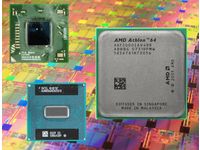Atom, Athlon, or Nano? Energy-Savers Compared
Which Is The Best Low-Power Platform?
Once AMD and Intel realized that pure clock speed isn’t the only way to improve performance, they started focusing on multi-core processors. They’ve been refining this concept by improving efficiency. The level of per-watt performance is what matters the most today, which is one of the main reasons for Intel’s success with its Core 2 processor family. But there are more than enough applications that do not require a lot of performance, and this is where AMD, Intel and VIA aim their low-power platforms. We compared an Athlon 64 2000+, Atom 230, Nano L2100 with the goal of figuring out which solutions serve up enough speed.
Low-Power Applications
While typical PC applications perform best mated to a full-featured processor—which today is a fast dual-core device—there are numerous applications that only need limited processing capabilities. Networking systems such as routers and firewalls operate well with limited CPU power as long as the number of users and features like QoS (quality of service) or encrypted VPN connections are low.
Thin clients in enterprise environments are another example. If users don’t have to handle massive applications then they won’t need powerful systems. Systems that control industrial devices in assembly lines, check-out registers, and kiosks work well with these low-power processors in many cases. Finally, an increasing number of low-cost PCs and nettop desktops (as opposed to net books) are powered by low-cost and low-power processors.
Where Low Power Becomes A Drawback
It is important to draw a clear line and separate low-power systems from high-efficiency systems, as these are two different things. A low-power system consumes as little power as possible to conserve energy, to reduce the need for cooling, or to reduce operating cost by saving energy for systems and air conditioning as well as by using simpler architectures. However, such a low-power system may not necessarily be efficient as well, just like a high-efficiency system does not have to be a low-power machine.
Your choice depends on your requirements. If the workload is predictable and controllable at all times, then it is safe and reasonable to purchase low-power solutions to keep costs down. This is the market segment that AMD, Intel, and VIA target with the products we review in this article. But if the workload could change and may even increase, a higher-power system that not only delivers more performance, but also offers greater efficiency (measured in performance per watt) is typically the better choice.
Get Tom's Hardware's best news and in-depth reviews, straight to your inbox.
Low-Power Processor Vendors
VIA is the only processor firm that has catered to the low-power market for many years. However, we want to make it clear that our focus is on the traditional computing market and there are many other suppliers that cater to specific niche applications. While VIA lacks the size and clout to compete directly against AMD and Intel in all the markets on which the two chip giants focus, VIA has a significant presence in the low-power market segment. VIA started with the C3 and C7 processors. The Nano family is pin-compatible with the C7 and provides much increased performance within the existing VIA power envelopes, mostly on VIA’s Mini-ITX or Nano-ITX platforms.
Intel has discovered the same market with its Atom family, which has been available as a single-core devices, while dual-core versions of the architecture are beginning to show up. Atom has a new pin-out, and it also utilizes Intel’s well-known front-side bus and mature chipsets. The Atom dual core will be the first low-power dual-core processor and it is the smallest low-power product available today thanks to Intel’s 45-nm manufacturing.
The selection of a low-power product is more difficult with AMD—the Geode LX is a low-power device, but its performance is not sufficient for PC applications. Geode NX is based on the Athlon XP, which requires an outdated platform. However, we received a low-power Athlon 64 2000+ processor for Socket AM2 some months ago, and this processor is rated at a TDP of only 8 W. Although this is not a commercial product (yet), it does a good job of showing what a low-power version of the device would offer for mainstream PC applications.
Current page: Which Is The Best Low-Power Platform?
Next Page AMD Athlon 64 2000+